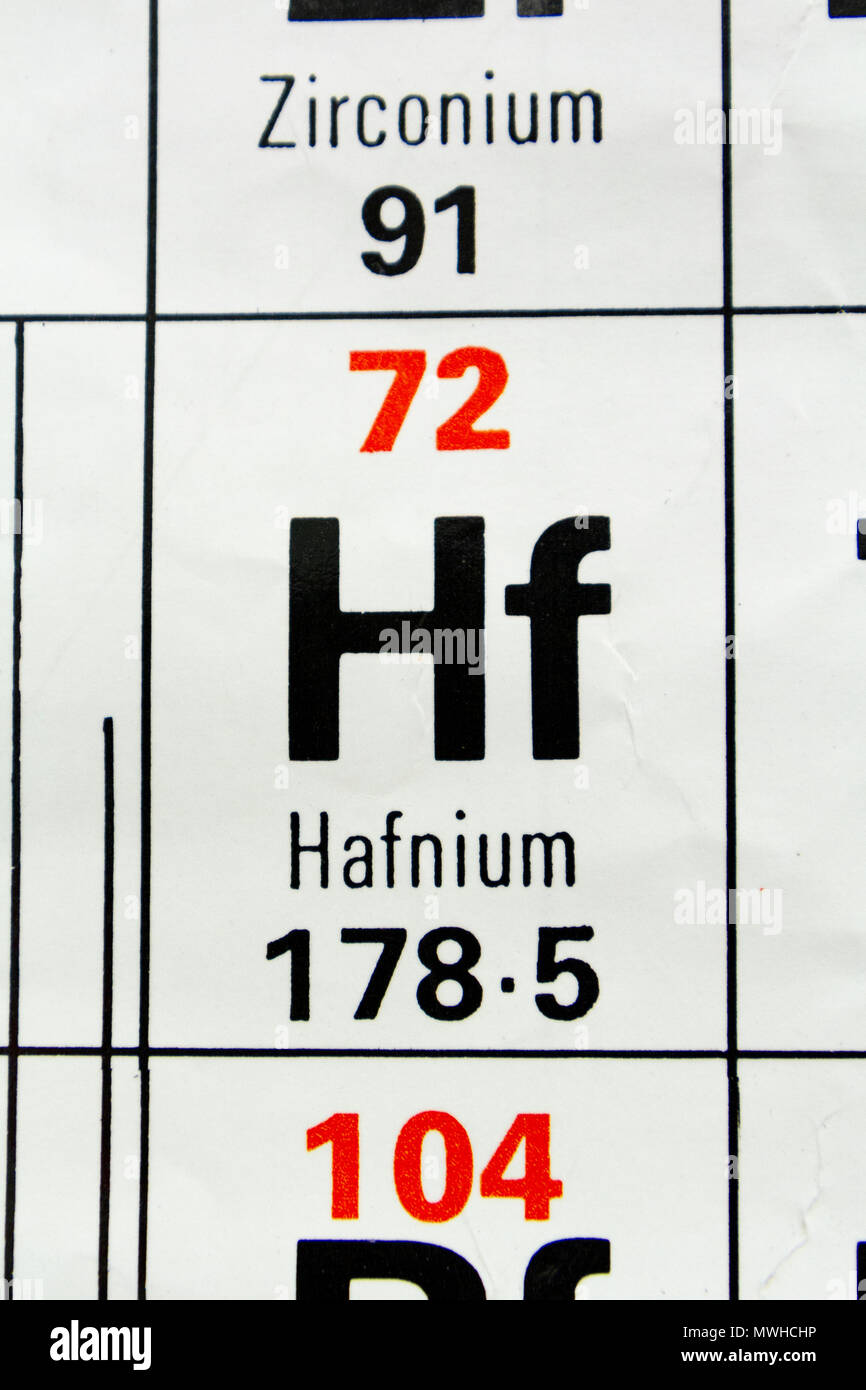Hafnium is a chemical element with atomic number 72 which means there are 72 protons and 72 electrons in the atomic structure. The chemical symbol for Hafnium is Hf. Hafnium is a lustrous, silvery gray, tetravalent transition metal, hafnium chemically resembles zirconium and is found in many zirconium minerals. Atomic Number of Hafnium Atomic Number of Hafnium is 72. Chemical symbol for Hafnium is Hf. Number of protons in Hafnium is 72. Hafnium is a chemical element with symbol Hf and atomic number 72. In chemical terms, it very closely resembles Zirconium and is only found in Zirconium minerals as a solid solution. As a result, it does not exist as a free element on Earth and is therefore one of the rarest elements in commercial use, with only around 70 MT being produced. Atomic Structure of Hafnium; Chemical Properties of Hafnium; Physical Properties of Hafnium; Regulatory / Health; Who/When/Where/How. Hafnium Page Two. Nuclides / Isotopes; Potential Parent Nuclides. Hafnium Page Three. Common Chemical Compounds of Hafnium. Overview of Hafnium. Atomic Number: 72; Group: 4; Period: 6; Series: Transition Metals.

Science -CHECK MY WORK-
a.) How can you describe the location of vanadium (V, atomic number 23) on the periodic table? Choose all that apply. 1. period 5, group 4 2. period 4, group 5 3. lanthanum series 4. nonmetals 5. transition metals b.) What is true
Math please check and thank you very much
Elements are arranged in the periodic table based on various patterns. For example, elements found in the rows near the top A. have higher atomic numbers than the elements in the rows near the bottom. B. all have the same atomic
HELP! EMERGENCY!!!
The elements of which of these groups on the periodic table are most resistant to forming compounds? A. Group 1 B. Group 9 C. Group 14 D. Group 17 Look on your periodic table at the noble elements also referred to as the inert
Chemistry
What limitations might an atomic model have in properly illustrating the structure of an atom? An atomic model cannot be used to represent the relative number of each subatomic particle within a specific atom. An atomic model
You can view more similar questions or ask a new question.
Hafnium
| Atomic Number: | 72 | Atomic Radius: | 212 pm (Van der Waals) |
| Atomic Symbol: | Hf | Melting Point: | 2233 °C |
| Atomic Weight: | 178.5 | Boiling Point: | 4603 °C |
| Electron Configuration: | [Xe]6s24f145d2 | Oxidation States: | 4, 3, 2, 1, −2 (an amphoteric oxide) |



History
From Hafinia, the Latin name for Copenhagen. Many years before its discovery in 1923 (credited to D. Coster and G. von Hevesey), Hafnium was thought to be present in various minerals and concentrations. On the basis of the Bohr theory, the new element was expected to be associated with zirconium.
It was finally identified in zircon from Norway, by means of X-ray spectroscope analysis. It was named in honor of the city in which the discovery was made. Most zirconium minerals contain 1 to 5 percent hafnium.
It was originally separated from zirconium by repeated recrystallization of the double ammonium or potassium fluorides by von Hevesey and Jantzen. Metallic hafnium was first prepared by van Arkel and deBoer by passing the vapor of the tetraiodide over a heated tungsten filament. Almost all hafnium metal now produced is made by reducing the tetrachloride with magnesium or with sodium (Kroll Process).
Properties
Hafnium is a ductile metal with a brilliant silver luster. Its properties are considerably influenced by presence of zirconium impurities. Of all the elements, zirconium and hafnium are two of the most difficult to separate. Although their chemistry is almost identical, the density of zirconium is about half of hafnium. Very pure hafnium has been produced, with zirconium being the major impurity.
Hafnium has been successfully alloyed with iron, titanium, niobium, tantalum, and other metals. Hafnium carbide is the most refractory binary composition known, and the nitride is the most refractory of all known metal nitrides (m.p. 3310C). At 700 degrees C hafnium rapidly absorbs hydrogen to form the composition HfH1.86.
Hafnium is resistant to concentrated alkalis, but at elevated temperatures reacts with oxygen, nitrogen, carbon, boron, sulfur, and silicon. Halogens react directly to form tetrahalides.
Uses
Because the element not only has a good absorption cross section for thermal neutrons (almost 600 times that of zirconium), but also excellent mechanical properties and is extremely corrosion-resistant, hafnium is used for reactor control rods. Such rods are used in nuclear submarines.
Hafnium is used in gas-filled and incandescent lamps, and is an efficient getter for scavenging oxygen and nitrogen.
Hf Element

Hafnium Atomic Mass Atomic Number
Handling
Finely divided hafnium is pyrophoric and can ignite spontaneously in air. Care should be taken when machining the metal or when handling hot sponge hafnium.
Hafnium Atomic Number Symbol
Exposure to hafnium should not exceed 0.5 mg/hr. (8 hour time-weighted average - 40-hour week).
